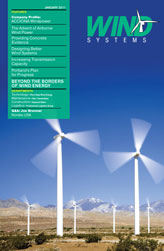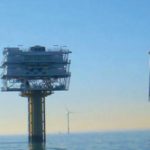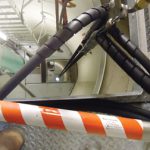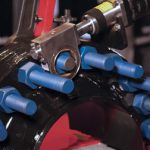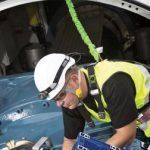As an active participant in the wind industry, you’ve likely heard or read about the wind-related innovations taking place in and around Portland, Oregon. You may know a bit about Portland’s burgeoning leadership in this arena. When you see the entire picture, however, you truly begin to appreciate the explosive wind scene in progress there.
Portland’s position in the wind arena is both a strategic stance, based on the city’s five-year economic development plan to build the most sustainable economy in the world, and a natural outgrowth of its particular set of attributes developed over time that make increasingly more sense for the local and regional growth of this industry.
As one of the nation’s greenest cities, and a central player in the clean tech cluster economy, Portland and its partners have worked to maximize the competitive environment for local businesses. By positioning these businesses as leaders in the green economy, developing analyses and specific strategies to remove obstacles and address opportunities for growth, Portland is paving the way for big investments in wind power.
The Green Talent Pool
The first reason Portland is leading the way in the wind industry is because it hosts one of the most significant concentrations in the United States of firms in the renewable energy, environmental services, recycling, and green building sectors. In particular, the city is home to a notable number of green building and wind energy firms, including the North American headquarters of both Vestas Americas and Iberdrola Renewables. Many of these companies are already developing and using wind energy resources and providing services for ongoing maintenance of wind installations. Figure 1
Equally important is the growing supply of experienced employees for clean tech firms: the region has built a critical mass of knowledge, expertise, and personnel that isn’t duplicated elsewhere. The Portland area’s renewable energy talent clusters are 84 percent greater than similar-sized regions, and 43 percent greater for environmental services and recycling. Consequently, when clean tech and other green firms are seeking a location to form or expand their businesses, Portland lands at or near the top of the list.
Manufacturing Strength
Portland’s second strength in the wind sector comes from its strong manufacturing base, which presents plenty of opportunities to develop a regional supply chain. The city is primed to work with local companies to help them participate in that business.
Numerous metal and steel companies with a long history of providing transportation equipment products use high technology tools to produce a finished product or part or enhance manufacturing capabilities, all of which fit well with the needs of the wind industry. Such manufacturers can supply the wind industry with rotors, generators, towers, and other components needed for wind turbines. In some cases companies have already launched their new role in the supply chain.
Ready for Action
Third, Portland is primed for action. Both Portland General Electric (PGE) and Pacific Power were early entrants to the wind market, giving Oregon a jump on the competition for installed wind projects, and creating new opportunities for regional manufacturing firms to provide repair and maintenance services for wind turbines. Nationally, Oregon and Washington rank fourth and fifth respectively for installed wind power.
Total installed and under construction wind capacity is more than 5,263 megawatts in Washington and Oregon, providing one of the largest installed markets in the U.S. The region’s strong environmental policies, which drove early adoption of aggressive renewable portfolio standards and tax credits, have also encouraged demand.
By sourcing regionally, owners and operators can reduce transportation costs and shorten lead times for replacement parts, decreasing overall operational costs. The Northwest has competitive, established firms that can provide raw steel, fabrication of large castings, hydraulic systems, gearbox repair/services, machining capabilities, and fiberglass operations. Other opportunities include electronics, metal shredding, blasting, coatings, and heat-treating. Figure 2
The Portland region’s deep bench in the manufacture of highly specialized engineered metal includes EVRAZ/Oregon Steel (raw steel), Oregon Iron Works, Gunderson, and Vigor Industrial (machining, fabrication, and assembly work). Each of these firms brings existing infrastructure, an experienced labor force, and large sites and buildings, as well as accessible locations near transportation corridors linked by rail, barge, and freeway to existing markets.
Building Capacity
The fourth reason Portland is paving the path in the wind arena is because it has put an array of tools to work on behalf of its regional wind suppliers, using partnerships, technical and financial assistance, and networking and promotion to help companies meet potential new customers and advance their specialized expertise.
Partnering for Lean Processes
For wind companies to supply original equipment manufacturers they need to understand the importance of Lean, 6 Sigma, and ISO 9000. A recent multimillion-dollar grant from the U.S. Department of Labor to the Oregon Manufacturing Extension Partnership (OMEP) addresses that need, offering workforce training and supply chain development for regional companies involved in the renewable energy sector or those interested in entering that sector. The technical assistance includes helping existing and new supplier companies incorporate lean processes into their production to improve quality and increase efficiency. Portland manufacturers receiving OMEP assistance have experienced overall productivity improvements of between 40-60 percent, resulting in increased sales, job creation and retention, and a resumption of the manufacture of previously off-shored items.
Financing
The City of Portland and the Portland Development Commission (PDC), as its economic development agency, work with the State of Oregon to offer competitive tax incentives that foster the growth and prosperity of manufacturing businesses. Financing programs address working capital, equipment purchase, real estate acquisition, tenant improvements, property development, and façade improvements.
Creating Connections
This past spring a team of Portland-Vancouver businesses and public officials attended WINDPOWER 2010, the world’s largest wind power event hosted by the American Wind Energy Association (AWEA). Calling themselves “The Pacific Northwest Wind Team” the trade show group included industry leaders from eight wind supply chain companies, as well as regional economic development representatives. Collectively, the delegation showcased the region’s manufacturing expertise, identified potential business opportunities, and sparked the development of a regional network for the industry. Through the WINDPOWER partnership the region’s suppliers generated new sales and business leads, and gained a better understanding of how they fit in the industry.
PDC also led the way in helping the WINDPOWER show attendees access MarketLink, a service launched by the Oregon Microenterprise Network and based on economic gardening tenets, which focus on creating a nurturing environment for existing companies rather than recruiting businesses from elsewhere. MarketLink provided customized market research, competitive intelligence, and industry and sales lead generation to new suppliers who wanted to diversify into the growing wind industry but needed additional information on markets, customers, and competitors. Figure 3
In addition to efforts such as the AWEA show, PDC facilitates monthly meetings to encourage collaborations among government, non-profit, and member associations focusing on this cluster. By coordinating efforts PDC has been able to partner, leverage, and coordinate efforts to assist the industry. Additional assistance has taken the form of “matchmaking”—inviting regional suppliers to pitch their services and capabilities to major owners/operators, including Vestas, Iberdrola, PGE, and others. These buyers have identified parts and services they prefer to source regionally, and in turn the sellers and suppliers are learning more about demand, requirements, and processes.
Connection takes place online, as well, with The Northwest Connectory, which is a recent addition to the toolkit [www.nwconnectory.com]. The Connectory is an online database that contains detailed profiles of Pacific Northwest companies in all industries at every level of the supply chain, including their capabilities, products, and services. The purpose of the tool is to link Oregon businesses to opportunities around the region via a robust, searchable, online buyer-supplier database. It’s a free service, supported by Business Oregon and PDC and managed by the Pacific Northwest Defense Coalition.
Recent Successes
Last, leadership can only be claimed if it’s backed by a positive track record, and Portland has that. Recently announced expansions by major players in the wind industry point to the growing success of Portland’s strategic focus. Vestas, Iberdrola, and Moventas have all announced their commitment to expand in the metro area, strengthening the region’s leadership position in wind supply and development. Figure 4
• Vestas Americas is the world’s largest manufacturer of wind turbines. This giant established an early stronghold in the Pacific Northwest and strong company growth has allowed it to relocate its North American headquarters to Portland’s Pearl District. A former Meier & Frank warehouse is slated to become home to a new LEED-Platinum, 172,000 square-foot headquarters, with completion in 2012. The company, now staffed at 400 employees, has committed to adding 100 jobs within the next five years.
• Iberdrola Renewables has its North American headquarters and 400 employees in Portland, and it continues to expand in the city. The company recently invested in a new advanced wind energy control facility. This control center allows Iberdrola to monitor its U.S. wind turbines, wind farms, and substations. Approximately 25 full-time employees work at the control center. Iberdrola will likely add workers as the company expands its wind capacity in the United States.
• Moventas, a Finland-based supplier of wind turbine gears, is expanding its existing facility in Portland for gear service and repairs. The company will add a new assembly production line to keep up with regional growth.
With these significant investments, an array of promising new prospects for local businesses, and the region’s continued commitment to its fast-growing wind industry base, Portland is a competitive business environment for wind power, worthy of participation from companies around the world.



















